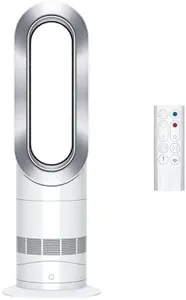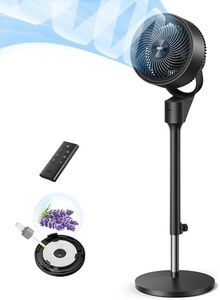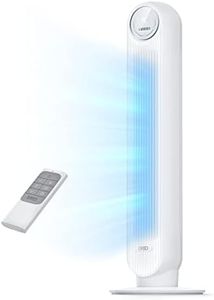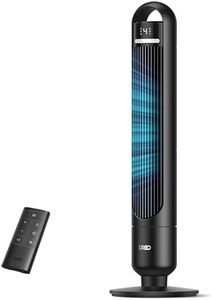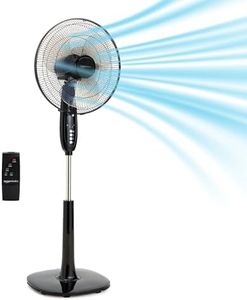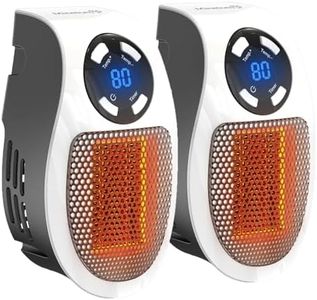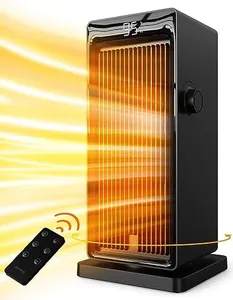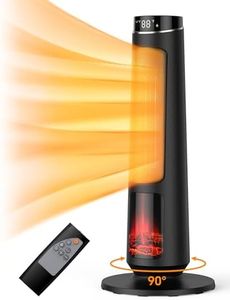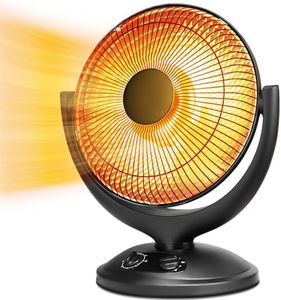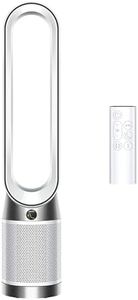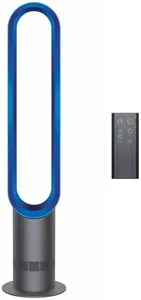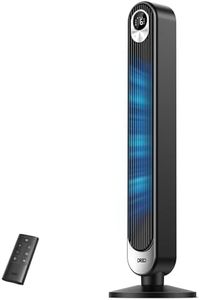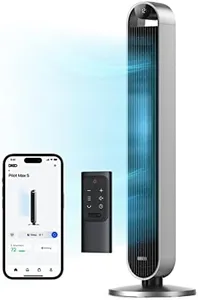10 Best Oscillating Fans 2026 in the United States
Our technology thoroughly searches through the online shopping world, reviewing hundreds of sites. We then process and analyze this information, updating in real-time to bring you the latest top-rated products. This way, you always get the best and most current options available.

Our Top Picks
Winner
Dyson Hot+Cool™ AM09 Jet Focus heater and fan
Most important from
1894 reviews
The Dyson Hot+Cool™ AM09 Jet Focus heater and fan is a versatile device designed for indoor use. Its tower form factor makes it suitable for rooms where space is a concern. The fan employs Air Multiplier technology to create an uninterrupted stream of air, which can be particularly beneficial for both cooling and heating, depending on the season.
One of its standout features is the Jet Focus control, which allows users to switch between Focused and Diffused modes for personalized or whole-room temperature control. This flexibility is complemented by a sleep timer that can be set from 15 minutes up to 9 hours, ensuring convenience and energy efficiency during use. The remote control, which is curved and magnetized for easy storage, adds to the user-friendliness of the product.
The oscillation range of 70 degrees ensures that airflow is evenly distributed around the room. The product’s premium features and the Dyson brand typically come with a higher price tag, which might not suit every budget. For those looking for a multi-functional device that combines heating and cooling with advanced features, the Dyson Hot+Cool™ AM09 could be a strong contender.
Most important from
1894 reviews
Dreo Fan for Bedroom, 80° Oscillating Standing Fan, 25dB Quiet, 80ft Pedestal Fans for Home Office, 90° Manual Vertical, 3 Speeds, Remote, 34-41" Adjustable Height, Air Circulator
Most important from
2681 reviews
The Dreo Fan for Bedroom is a solid choice if you want a quiet, adjustable oscillating fan designed for indoor rooms like bedrooms, living rooms, or home offices. It stands about 41 inches tall with an adjustable height between 34 and 41 inches, making it easy to direct airflow exactly where you need it—whether low for kids or high near the bed. The fan oscillates 80 degrees horizontally and can tilt 90 degrees vertically, giving flexible air circulation.
It offers 3 speed settings plus an auto mode that adjusts fan speed based on room temperature, which is handy for maintaining comfort without manual changes. Noise levels are impressively low at 25dB, quieter than a whisper, which is ideal for light sleepers or quiet workspaces. Control is convenient with both a touch panel and a remote, allowing you to adjust speed, oscillation, and even mute any beep sounds. The fan also supports easy cleaning by detaching the blade and grills, and it includes an aroma pad for freshening the air.
The fan requires assembly and uses AC power, so it’s not cordless, which could limit placement options depending on outlet availability. Additionally, it requires one C battery for the remote, which is included. While it doesn’t have specific energy efficiency ratings noted, its design aims for smooth airflow with minimal noise, suggesting reasonable power use. This fan suits those looking for a quiet, versatile, and easy-to-control pedestal fan that can cover a large area with gentle but effective airflow.
Most important from
2681 reviews
Dreo Tower Fan for Bedroom, 25ft/s Velocity Quiet Floor Fan, 90° Oscillating Fans for Indoors with 4 Speeds, 4 Modes, 8H Timer, Standing Fans, Bladeless Fan, White, Nomad One (DR-HTF007)
Most important from
42577 reviews
The Dreo Tower Fan for Bedroom (Nomad One DR-HTF007) is a compact 36-inch tower fan designed to quickly cool your living spaces with its powerful airflow system, capable of reaching speeds up to 25ft/s. It features a 90° oscillation range, which helps to cover a larger area in the room, making it a good option for bedrooms, living rooms, and kitchens. The fan offers customizable comfort with 4 speed settings and 4 operating modes, allowing you to adjust it to your preference, whether you need a gentle breeze or a stronger flow of air.
This fan is also easy to clean, thanks to its removable rear grille and impeller wheel, and it prioritizes safety with fingertip pinch-proof grills and built-in circuit protection. One of its standout features is its quiet operation, with a noise level as low as 28 dB, which is ideal for a restful sleep or a peaceful environment. The integrated 8-hour timer and auto-mute in sleep mode further enhance its usability during nighttime.
With the inclusion of both touch and remote control, convenience is added, allowing you to operate the fan without getting up. However, while the fan offers many features and strong airflow, it might not be the best choice for large rooms or spaces that require extensive cooling. Additionally, its energy efficiency is not specifically highlighted, so it may be worth considering if energy consumption is a primary concern for you.
Most important from
42577 reviews
Buying Guide for the Best Oscillating Fans
When you're looking to buy an oscillating fan, the main goal is to find a model that keeps your space comfortable and cool while being easy to use and fitting your needs. Oscillating fans move air by rotating back and forth, helping to distribute cool air evenly throughout a room, rather than just blowing it in one direction. It's important to consider where you will use the fan, how much noise you can tolerate, how much space you have, and how much airflow you need. Here are the key features and specs you should know about before choosing the right oscillating fan for you.FAQ
Most Popular Categories Right Now


